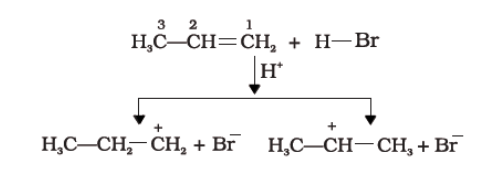
How is propene converted into 1−bromopropane and 2−bromopropane?
Answer
487.5k+ views
1 likes
Hint: To answer this question, you should recall the concept of an electrophilic addition of halogens to a double bond. Markovnikov rule is an important rule for the prediction of products of addition reaction of unsymmetrical alkenes in organic chemistry.
Complete step by step solution:
Addition of
The addition of hydrogen halide to an unsymmetrical alkene gives two products. Propene when undergoes reaction with hydrogen bromide forms
When reacted with
Addition of
1. An electrophile, H+ is generated from hydrogen bromide which attacks the double bond to form a carbocation.

2. Since the secondary carbocation is more stable than the primary carbocation, the secondary carbocation predominates the formation of ions.

3. Finally,
Note: Anti-Markovnikov rule explains the regiochemistry where the substituent is bonded to a less substituted carbon, rather than the more substituted carbon. This process is quite unusual, as carbocations which are commonly formed during alkene, or alkyne reactions tend to favour the more substituted carbon. Anti Markovnikov addition reaction is found to follow a free radical mechanism. The peroxide compound involved helps in the generation of free radicals. A general mechanism of anti-Markovnikov addition reaction is discussed below:
1. Generation of free radical through homolytic cleavage of peroxide compound.
2. Attack of generated free radical on hydrogen halide to form halide radical through homolysis
3. Attack of generated halide radical on alkene molecule to form alkyl radical through homolysis.
4. Attack of a generated alkyl radical on hydrogen halide to form alkyl halide through homolytic cleavage of hydrogen halide bond.
Complete step by step solution:
Addition of
The addition of hydrogen halide to an unsymmetrical alkene gives two products. Propene when undergoes reaction with hydrogen bromide forms
When reacted with
Addition of
1. An electrophile, H+ is generated from hydrogen bromide which attacks the double bond to form a carbocation.

2. Since the secondary carbocation is more stable than the primary carbocation, the secondary carbocation predominates the formation of ions.

3. Finally,
Note: Anti-Markovnikov rule explains the regiochemistry where the substituent is bonded to a less substituted carbon, rather than the more substituted carbon. This process is quite unusual, as carbocations which are commonly formed during alkene, or alkyne reactions tend to favour the more substituted carbon. Anti Markovnikov addition reaction is found to follow a free radical mechanism. The peroxide compound involved helps in the generation of free radicals. A general mechanism of anti-Markovnikov addition reaction is discussed below:
1. Generation of free radical through homolytic cleavage of peroxide compound.
2. Attack of generated free radical on hydrogen halide to form halide radical through homolysis
3. Attack of generated halide radical on alkene molecule to form alkyl radical through homolysis.
4. Attack of a generated alkyl radical on hydrogen halide to form alkyl halide through homolytic cleavage of hydrogen halide bond.
Latest Vedantu courses for you
Grade 10 | CBSE | SCHOOL | English
Vedantu 10 CBSE Pro Course - (2025-26)
School Full course for CBSE students
₹37,300 per year
Recently Updated Pages
Master Class 11 Economics: Engaging Questions & Answers for Success

Master Class 11 Business Studies: Engaging Questions & Answers for Success

Master Class 11 Accountancy: Engaging Questions & Answers for Success

Master Class 11 English: Engaging Questions & Answers for Success

Master Class 11 Computer Science: Engaging Questions & Answers for Success

Master Class 11 Maths: Engaging Questions & Answers for Success

Trending doubts
State and prove Bernoullis theorem class 11 physics CBSE

1 ton equals to A 100 kg B 1000 kg C 10 kg D 10000 class 11 physics CBSE

State the laws of reflection of light

One Metric ton is equal to kg A 10000 B 1000 C 100 class 11 physics CBSE

Difference Between Prokaryotic Cells and Eukaryotic Cells

1 Quintal is equal to a 110 kg b 10 kg c 100kg d 1000 class 11 physics CBSE




